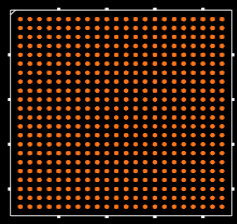EP2C50F484I8N FPGAs: Features, Alternatives and FAQs
2024-12-17 11:12:32 802
EP2C50F484I8N Description
The EP2C50F484I8N is part of the Cyclone II family of FPGA (Field-Programmable Gate Arrays) by Intel (formerly Altera). It is a mid-range FPGA that offers a cost-effective solution for a wide range of digital logic applications. The Cyclone II series is designed for applications that require a balance of low power consumption, high performance, and low cost. The EP2C50F484I8N is a 50K logic element FPGA with 484 pins, designed to support a wide range of digital designs, including custom logic, embedded systems, and signal processing applications.
The FPGA features an array of logic cells, embedded memory blocks, and high-speed I/O, providing designers with flexibility in creating custom circuits and systems. The device is used in applications where custom logic or specialized functionality is required, and it can be reprogrammed to meet changing design needs.
EP2C50F484I8N Features
50K Logic Elements:
The FPGA contains 50,000 logic elements (LEs), which are basic building blocks for implementing custom logic functions.
Speed Grade:
The device operates at 8 ns (nanoseconds) for high-speed applications.
Embedded Memory Blocks:
The FPGA includes embedded memory blocks such as Block RAM (BRAM) for storing data locally within the FPGA.
I/O Pins:
The EP2C50F484I8N has 484 pins with various I/O standards, supporting high-speed serial and parallel interfaces.
Low Power Consumption:
The FPGA is designed for low-power operation, which is critical for battery-powered devices and embedded systems.
On-chip Logic:
The device supports high-density logic functions, making it ideal for complex designs that require custom data processing.
Embedded Multipliers:
The FPGA includes embedded multipliers to perform high-speed arithmetic operations, which is useful in signal processing and digital signal applications.
Reconfigurability:
As a programmable logic device, the EP2C50F484I8N can be reconfigured to meet evolving design needs, providing flexibility.
Support for Various I/O Standards:
It supports multiple I/O standards (LVCMOS, LVTTL, etc.), making it compatible with various external components.
Built-in Design Tools Support:
The Intel Quartus Prime software suite offers an integrated environment for designing, simulating, and programming the FPGA.
EP2C50F484I8N Applications
Embedded Systems:
The EP2C50F484I8N is used in embedded systems requiring custom processing logic, such as embedded controllers and microcontroller-based systems.
Signal Processing:
With its embedded multipliers and logic elements, the FPGA is ideal for digital signal processing (DSP) applications, including audio and video processing.
Networking:
It is used in networking hardware, such as routers and switches, where custom logic is required to process data at high speeds.
Industrial Automation:
The FPGA is used in industrial applications like control systems, machine vision, and robotics, where customized logic needs to be implemented for specific tasks.
Consumer Electronics:
It is employed in consumer electronics, including set-top boxes, media players, and smart devices for customizable functionalities.
Automotive Systems:
The FPGA can be used in automotive electronics for tasks like advanced driver assistance systems (ADAS), sensor fusion, and in-vehicle networking.
Medical Devices:
In the medical industry, the FPGA is used for signal acquisition, image processing (e.g., MRI and ultrasound), and data conversion applications.
Aerospace and Defense:
The EP2C50F484I8N can be used in aerospace and defense applications, such as radar systems, satellite communications, and secure data processing.
Test and Measurement:
It is ideal for test equipment and measurement systems where programmable logic is required for processing signals in real-time.
Custom Computing Systems:
Designers use it to create custom computing systems and accelerators, providing specialized hardware functionality for specific computational tasks.
EP2C50F484I8N CAD Model
Symbol

Footprint

EP2C50F484I8N Manufacturer
Intel Corporation is a leading global technology company that designs and manufactures advanced semiconductor products. Founded in 1968, Intel is best known for its microprocessors, which power most personal computers, servers, and embedded systems worldwide. The company is a key player in the fields of semiconductors, artificial intelligence, cloud computing, and 5G technologies. Intel's innovation spans areas such as data centers, autonomous driving, and IoT (Internet of Things), with a commitment to delivering cutting-edge performance, efficiency, and security in its products.
EP2C50F484I8N Alternatives
Xilinx Spartan-6 XC6SLX50:
A competitive FPGA from Xilinx with similar features such as logic elements, low power consumption, and high-speed I/O for embedded applications.
Intel MAX 10 FPGA:
A lower-cost alternative to the Cyclone II series, designed for applications requiring moderate complexity and low power.
Lattice ECP5:
A mid-range FPGA solution from Lattice Semiconductor that offers low power consumption and high-speed processing suitable for signal processing and communications.
Xilinx Artix-7:
Another competitive offering from Xilinx, known for its high-performance logic fabric, low power consumption, and robust I/O support.
Microsemi IGLOO2:
A low-power FPGA with similar functionality to the EP2C50F484I8N, designed for automotive, industrial, and communications applications.
EP2C50F484I8N FAQs
Can the EP2C50F484I8N FPGA process quantum data?
Answer: No, the EP2C50F484I8N is a classical FPGA designed for digital logic and signal processing, and does not support quantum computing tasks.
Is the EP2C50F484I8N FPGA waterproof?
Answer: No, the FPGA itself is not waterproof. However, it can be used in waterproof enclosures depending on the application.
Can the EP2C50F484I8N FPGA predict the weather?
Answer: No, the FPGA cannot predict the weather, though it could be used in a weather sensor network for processing data related to weather systems.
Is the EP2C50F484I8N FPGA compatible with time travel applications?
Answer: No, as of current technology, time travel is not a supported feature of any FPGA, including the EP2C50F484I8N.
Can the EP2C50F484I8N FPGA play video games like a console?
Answer: While the EP2C50F484I8N can be programmed for various purposes, it is not designed to run video games. However, it can be used to build custom game hardware or simulation systems.




